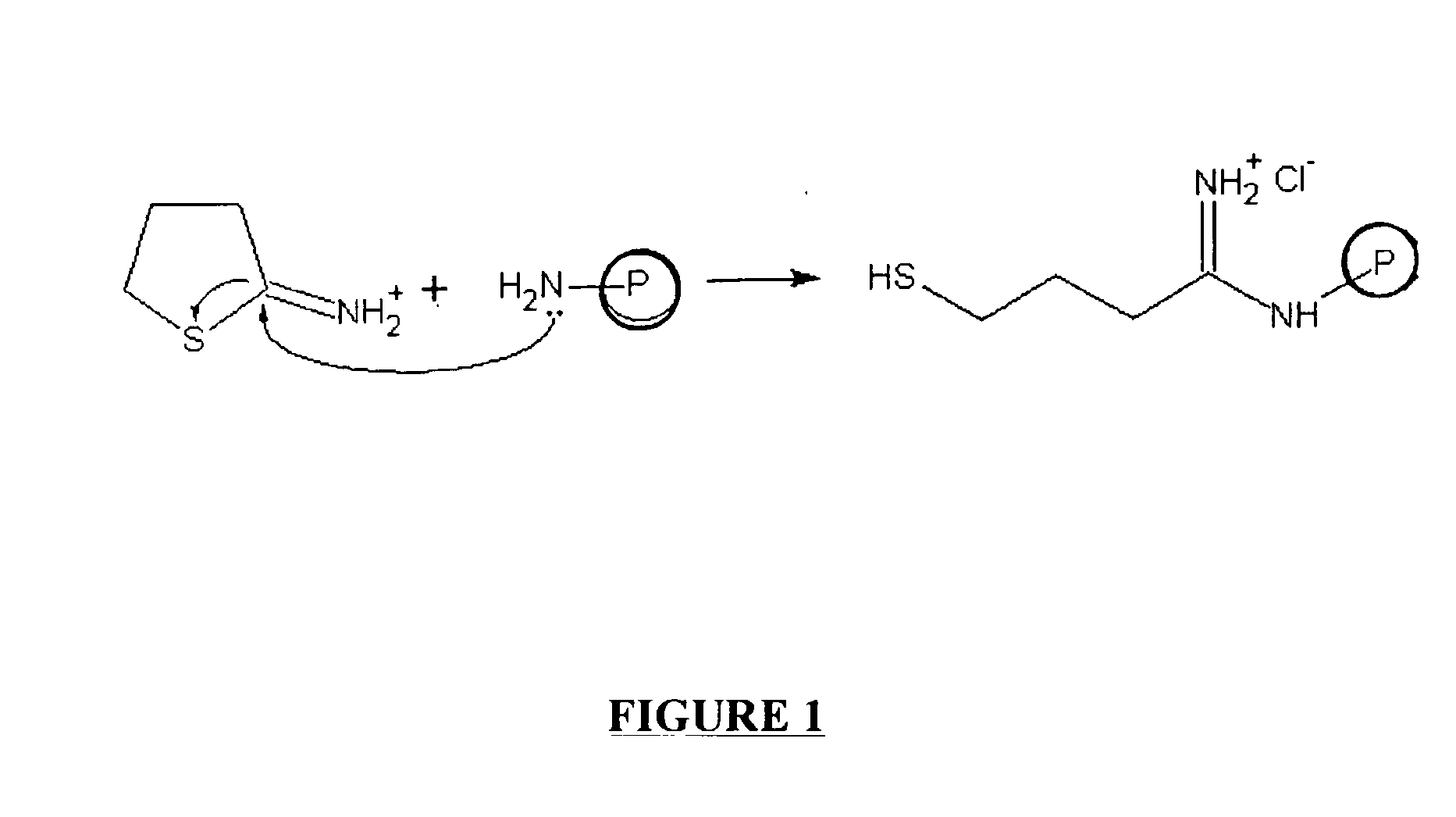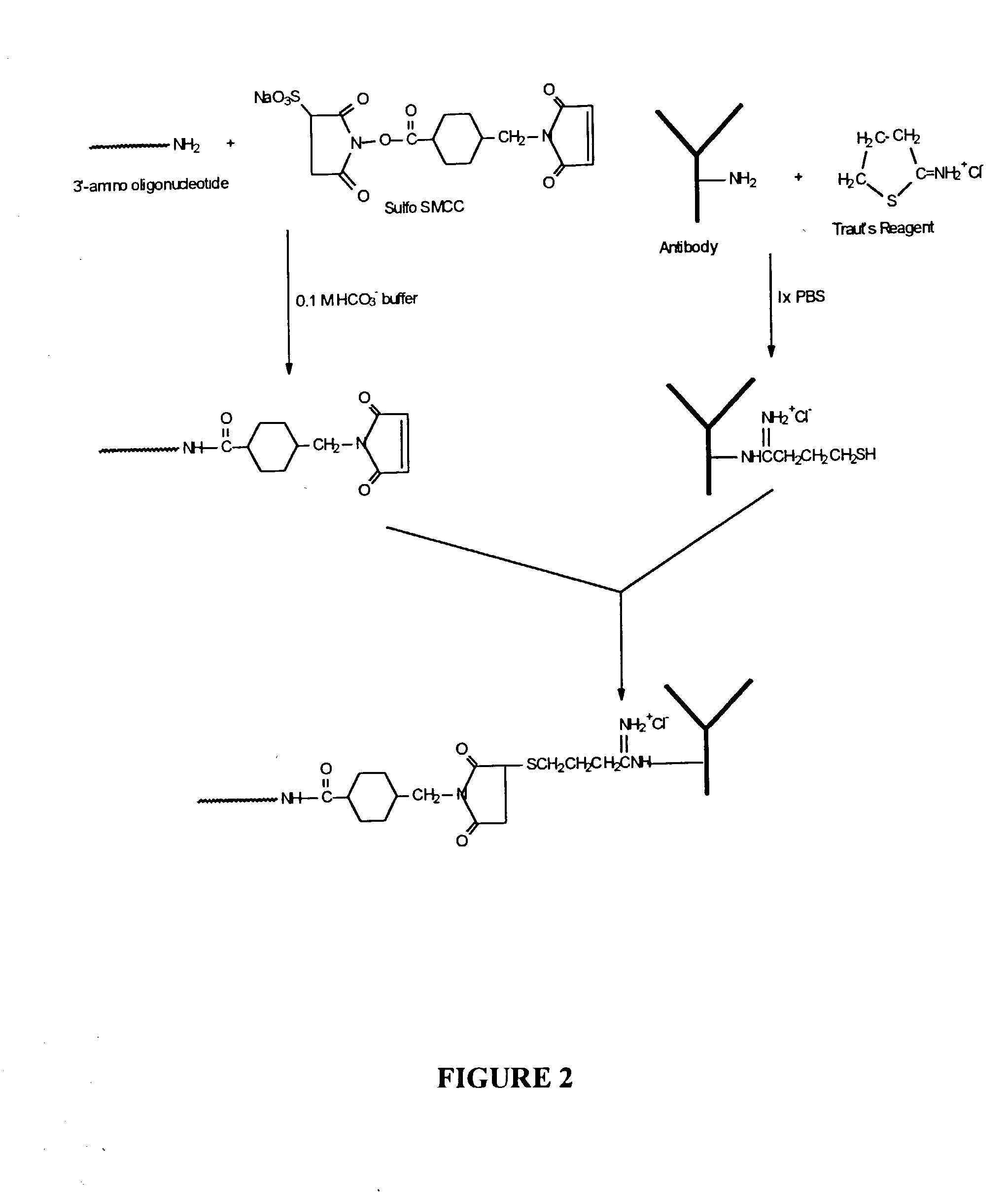Solid phase synthesis of biomolecule conjugates
a biomolecule and conjugate technology, applied in the field of biomolecule conjugate solid phase synthesis, can solve the problems of inconvenient forming of other conjugates, inability to produce protein-oligonucleotide conjugates, and inability to bind other conjugates, so as to prevent crosslinking via disulfide formation and enhance the rate and efficiency of reaction
- Summary
- Abstract
- Description
- Claims
- Application Information
AI Technical Summary
Benefits of technology
Problems solved by technology
Method used
Image
Examples
example 2
Solid-Phase Synthesis of Oligonucleotide-Antibody Conjugates Using Protein A-Sepharose
[0073] A 1 mL column of protein A-sepharose (Amersham Biotech) is prepared and equilibrated with 20 mM phosphate+3M NaCl, pH7.5. Two mg of mouse IgG is recirculated through the column at 1 mL / min until all of the protein is bound. A solution of 20 mM phosphate+3M NaCl+1 mM dithiothreitol (DTT) is then recirculated through the column for 1 hour at room temperature in order to convert some of the IgG disulfide bonds to thiol groups. Protein A does not contain disulfide bonds and is therefore not affected by this procedure. Subsequent to DTT treatment the column is washed extensively with 20 mM phosphate+3M NaCl. 32 A.sub.260 nm of Sulfo-SMCC treated oligonucleotide in 1 mL of 20 mM phosphate+3M NaCl is recirculated through the column overnight at room temperature, after which unreacted oligonucleotide is removed by extensive washing in this buffer. Conjugate is released by passing several mL of 20 mM...
example 3
Solid Phase Synthesis of Oligonucleotide-Antibody Conjugates Using Sulfopropyl Fast Flow Ion Exchange Media
[0074] One mL of Sulfopropyl Fast Flow ion exchange media (Amersham Biotech) is placed in a small disposable column and equilibrated with 20 mM Na Acetate, pH 6.0 Excess buffer is removed and 2 mg of mouse IgG in the same buffer is passed repeatedly over the column until all protein is bound. Excess buffer is removed and 32 A.sub.260 nm of sulfo-SMCC activated oligonucleotide in 1 mL of acetate buffer is added to the column. Both ends are capped and the column tumbled for 48 hours at room temperature. After extensive washing of the solid phase with acetate buffer to remove unreacted oligonucleotide the conjugate is released by flowing several mLs of 100 mM Tris+1 M NaCl, pH8, through the column. The formation of the conjugate was confirmed by CE or PAGE analysis.
example 4
Solid-Phase Synthesis of Oligonucleotide-Enzyme Conjugates Using Butyl Sepharose
[0075] A 1 mL column of butyl-sepharose (Amersham Biotech) is prepared and equilibrated with 20 mM phosphate+1M Na.sub.2SO.sub.4, pH7.5. One mg of horseradish peroxidase (Type V, Sigma Chemical Company) in 1 mL of the equilibrating buffer is added to the column and allowed to flow through. Binding of the enzyme is verified by monitoring the UV absorbance of the flowthrough. One mL of 10 mM iminothiolane in 20 mM phosphate+1M Na.sub.2SO.sub.4, pH7.5 is added to the column, which is then capped and tumbled for 1 hour at room temperature. The support is then thoroughly washed by uncapping the column and passing 20 mL of 20 mM phosphate+1M Na.sub.2SO.sub.4, pH7.5 through the gel bed. 16 A.sub.260 nm of Sulfo-SMCC treated oligonucleotide in 1 mL 20 mM phosphate+1M Na.sub.2SO.sub.4, pH7.5 is added to the column, which is then capped and tumbled overnight at room temperature. Uncoupled oligonucleotide is then r...
PUM
| Property | Measurement | Unit |
|---|---|---|
| pH | aaaaa | aaaaa |
| pH | aaaaa | aaaaa |
| absorbance | aaaaa | aaaaa |
Abstract
Description
Claims
Application Information
 Login to View More
Login to View More - R&D
- Intellectual Property
- Life Sciences
- Materials
- Tech Scout
- Unparalleled Data Quality
- Higher Quality Content
- 60% Fewer Hallucinations
Browse by: Latest US Patents, China's latest patents, Technical Efficacy Thesaurus, Application Domain, Technology Topic, Popular Technical Reports.
© 2025 PatSnap. All rights reserved.Legal|Privacy policy|Modern Slavery Act Transparency Statement|Sitemap|About US| Contact US: help@patsnap.com



